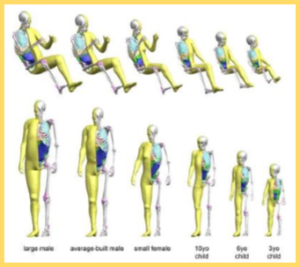 Toyota Motor has added three new models to represent children – ages ten, six, and three – to its virtual crash testing software. THUMS – Total Human Model for Safety – allows injuries sustained by human bodies during vehicle crashes to be simulated on computers. Toyota uses and sells the software through the Tokyo-based JSOL Corporation and ESI Japan.
Toyota Motor has added three new models to represent children – ages ten, six, and three – to its virtual crash testing software. THUMS – Total Human Model for Safety – allows injuries sustained by human bodies during vehicle crashes to be simulated on computers. Toyota uses and sells the software through the Tokyo-based JSOL Corporation and ESI Japan.
The newly launched child-spec models were created as a result of collaborative research between Wayne State University, the University of Michigan, and the Collaborative Safety Research Center* located in the Toyota Technical Center in Ann Arbor, Michigan.
Toyota claims that THUMS predicts injuries throughout the human body. It is used for the development of safety equipment such as airbags. THUMS is also being used by NASCAR to set regulations for seat shapes to reduce the likelihood of rib fractures sustained by drivers during racing accidents.
The ten-year old (138cm tall), six-year old (118cm tall) and three-year old (94cm tall) additions to THUMS Version 4 represent the average physiques of children at each respective age. As with the large male (189cm tall), average-build adult male (179cm tall), and small female (153cm tall) models that are already being sold, the new models will come in two versions — a passenger version and a pedestrian version — for a total of six new additions to the THUMS line-up.
*The Collaborative Safety Research Center was established in 2011. It aims to reduce the number of traffic fatalities and injuries through collaborative research with North American universities, hospitals and research agencies, and by sharing the results of this research with society. Between 2011 and 2021, it is scheduled to receive $85 million dollars in investment.

